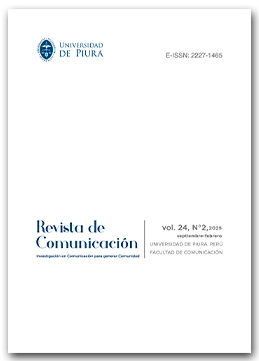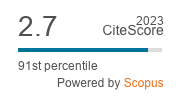Authorship and female representation in Spanish VOD television fiction (2016-2024): women as creators and protagonists
DOI:
https://doi.org/10.26441/RC24.2-2025-4022Keywords:
TV fiction, gender representation, women creators, Spanish TV series, female protagonism, TV and gender, video on demand (VOD), gender inequality, streaming platformsAbstract
Purpose. This study examines the presence of female creators and the prominence of female protagonists in Spanish television fiction produced for video-on-demand platforms between 2016 and 2024. The main objective is to identify gender inequalities in audiovisual creation and in the configuration of leading characters, as well as to analyze the relationship between the gender of the creative team and the representation of main characters in the narratives. Methodology. To achieve this, a mixed-methods approach is employed, combining quantitative and qualitative analysis on a sample of n = 222 Spanish series released on streaming platforms. Results and conclusions. The findings reveal a persistent gender imbalance in audiovisual creation, with only 15% of productions being exclusively created by women. In terms of protagonism, although there is a balance between male and female characters, differences emerge in narrative construction: male characters predominantly lead individual storylines, whereas female characters are more prevalent in ensemble narratives. Furthermore, a significant correlation is observed between female authorship and greater representation of women in leading roles. Original contribution. This study offers an overview of Spanish television fiction during the first decade of VOD platforms from a gender perspective. Based on a broad and recent sample, it introduces a distinctive approach that combines authorship, protagonism, and narrative construction to identify trends and structural contradictions. In doing so, it contributes to understanding current challenges to gender equality in audiovisual creation and provides tools for future research.
Metrics
References
Arranz, F. (coord.) (2008). Mujeres y hombres en el cine español. Una investigación empírica. Instituto de la Mujer.
Asociación de mujeres cineastas y de medios audiovisuales [CIMA]. (2023). Informe Anual CIMA. La representación de las mujeres del sector cinematográfico del largometraje español. https://tinyurl.com/2aa7j629
Audiovisual451. (26/03/2019). ‘SKAM España’ se desmarca de la versión original en su segunda temporada con la bendición de los productores noruegos. Audiovisual451. https://www.audiovisual451.com/skam-espana/
Banet-Weiser, S. (2018). Empowered: Popular Feminism and Popular Misogyny. Duke University Press. DOI: https://doi.org/10.1215/9781478002772
Cascajosa Virino, C. (2015). Mujeres pioneras y creación televisiva en España: una revisión crítica. Transversalidad de género en el audiovisual andaluz, 91.
Cascajosa Virino, C., & Pérez, N. M. (2016). Del cine a la televisión: hacia una genealogía de las mujeres guionistas en España. FEMERIS: Revista Multidisciplinar de Estudios de Género, 1(1/2), 25-34. DOI: https://doi.org/10.20318/femeris.2016.3225
Cascajosa, C. (2018). Las series de televisión españolas ante la llegada de los servicios VOD (2015-2017). El Profesional de la Información, 27(6), 1303-1312. https://doi.org/10.3145/epi.2018.nov.13 DOI: https://doi.org/10.3145/epi.2018.nov.13
Cascajosa-Virino, C. (2017). Tiempos difíciles, mujeres protagonistas: la obra televisiva de Virginia Yagüe. Revista de Investigaciones Feministas, 8(2), 385-400. DOI: https://doi.org/10.5209/INFE.55073
Cascajosa-Virino, C. (2019). Mar Coll's Matar al padre / Killing the Father (Movistar+ 2018): a female Auteur between film and television in Spain. Feminist Media Studies, 19(7), 977-990. https://doi.org/10.1080/14680777.2019.1667063 DOI: https://doi.org/10.1080/14680777.2019.1667063
Cattien, J. (2019). When 'feminism' becomes a genre: Alias Grace and 'feminist' television. Feminist Theory, 20(3), 321-339. https://doi.org/10.1177/1464700119842564 DOI: https://doi.org/10.1177/1464700119842564
Cobb, S. (2015). Adaptation, authorship, and contemporary women filmmakers. Palgrave Macmillan. DOI: https://doi.org/10.1057/9781137315878
Cobb, S. (2024). Adaptation, authorship and the critical conversations of Little Fires Everywhere. New Review of Film and Television Studies, 22(1), 316-336. https://doi.org/10.1080/17400309.2023.2264711 DOI: https://doi.org/10.1080/17400309.2023.2264711
Cruzado, M. A. (2006). Grietas en el techo de celuloide. Directoras del siglo XXI. En M. Arriaga (Coord.), Mujeres, espacio y poder (pp. 153-173). Arcibel Editores.
Cuenca Suárez, S. (2022). Informe CIMA 2021. La representatividad de las mujeres en los puestos de mayor responsabilidad del sector cinematográfico. https://urlis.net/3dbujyqx
Donstrup, M. (2019). Género y poder en la ficción televisiva: análisis textual ideológico de una serie histórica. Doxa Comunicación, 28, 97-109. DOI: https://doi.org/10.31921/doxacom.n28a05
El Confidencial. (2021, 26 de octubre). Abril Zamora desmonta 'Todo lo otro', la primera gran serie española de HBO Max. El Confidencial. https://tinyurl.com/48sswuvx
El Confidencial. (2021, 9 de julio). Miren Ibarguren: "En 'Supernormal' hay alegato feminista, algo necesario hasta que se normalice". El Confidencial. https://tinyurl.com/bdz9mcfy
Eurimages (2020). Gender Parity Statistics - Annual Data Collection and Publication Template 2018. Eurimages, Council of Europe.
Fontaine, G. (2024). Female professionals in European TV/SVOD fiction production 2015-2022 figures. European Audiovisual Observatory. https://surl.li/hitxtr
FormulaTV. (2024, 14 de julio). Entrevista a Verónica Sánchez: ¿Conseguirá Ángela desenmascarar a su peor pesadilla? [Video]. YouTube. https://youtu.be/2Vm60sjZa4Q?si=Jz02HMr4HXqpQLAy
Galán, E. (2007). Construcción de género y ficción televisiva en España. Comunicar, 15(28), 229-236.
Hallam, J. (2013). Drama Queens: making television drama for women 1990–2009. Screen, 54(2), 256-261. https://doi.org/10.1093/screen/hjt013 DOI: https://doi.org/10.1093/screen/hjt013
Hidalgo-Marí, T., y Palomares-Sánchez, P. (2020). Ser madre en la ficción televisiva: una comparativa entre series españolas y estadounidenses. Área Abierta, 20(1), 123-137. https://doi.org/10.5209/arab.62518 DOI: https://doi.org/10.5209/arab.62518
Hidalgo-Marí, T., y Sánchez-Olmos, C. (2024). Female creators, directors and screenwriters in TV fiction production in Spain (2000 to 2020): gender inequality and characteristics of the roles. Feminist Media Studies, 1-19. https://doi.org/10.1080/14680777.2024.2384419 DOI: https://doi.org/10.1080/14680777.2024.2384419
Higueras-Ruiz, M. J. (2019). Showrunners y personajes femeninos en las series de ficción de la industria televisiva norteamericana: Sharp Objects (Marti Noxon, HBO: 2018) y Killing Eve (Phoebe Waller-Bridge, BBC America: 2018). Admira: Análisis de Medios, Imágenes y Relatos Audiovisuales, 7(2), 85-106.
Kreager, A., & Follows, S. (2023). Gender inequality and screenwriters. A study of the impact of gender on equality of opportunity for screenwriters and key creatives in the UK film and television industries. The Writers Guild of Great Britain. https://tinyurl.com/ms24xu97
Lacalle, C., & Gómez, B. (2016). La representación de las mujeres trabajadoras en la ficción televisiva española. Comunicar: Revista Científica de Comunicación y Educación, 24(47), 59-67. DOI: https://doi.org/10.3916/C47-2016-06
Lauzen, M. (2025). It’s a man’s (celluloid) world: Portrayals of female characters in the top grossing U.S. films of 2024. Center for the Study of Women in Television and Film, San Diego State University. https://tinyurl.com/4sxz93m9
Ley Orgánica 3/2007, de 22 de marzo, para la igualdad efectiva de mujeres y hombres. Boletín Oficial del Estado, 71, de 23 de marzo de 2007. https://www.boe.es/eli/es/lo/2007/03/22/3/con
López-Rodríguez, F. J., & Raya-Bravo, I. (2019). Teresa Fernández-Valdés and female-produced TV series in Spain. Cable Girls/Las chicas del cable as case study. Feminist Media Studies, 19(7), 962–976. https://doi.org/10.1080/14680777.2019.1667062 DOI: https://doi.org/10.1080/14680777.2019.1667062
Martin, A. (2003). Refocusing authorship in women’s filmmaking’. In J. Levitin, J. Plessis, and V. Raoul (eds), Women Filmmakers: Refocusing. Routledge. DOI: https://doi.org/10.59962/9780774850407-005
Martínez Tejedor, M. C. (2008). Women on the other side of the camera: Where are the women cinema directors? Espacio, Tiempo y Forma, 20-21, 315–340. https://doi.org/10.5944/etfvii.20-21.2007.1479 DOI: https://doi.org/10.5944/etfvii.20-21.2007.1479
Martínez, A. M. C., & Tudela, A. N. (2011). Mujeres e (industria) audiovisual hoy: Involución, experimentación y nuevos modelos narrativos. Teoría de la Educación. Educación y Cultura en la Sociedad de la Información, 12(2), 8-24. DOI: https://doi.org/10.14201/eks.8271
McCausland, E. (2017). Wonder Woman: El feminismo como superpoder. Errata Naturae.
Mujer Hoy. (2024, 26 de febrero). Verónica Fernández, la cazadora de historias que decide a qué serie vas a engancharte en Netflix. Mujer Hoy. https://tinyurl.com/4cb346b4
Núñez Domínguez, T. (2010). Female movie directors: A challenge, a hope. Pixel-Bit, 37, 121–133. https://www.redalyc.org/articulo.oa?id=36815118010
Núñez Domínguez, T., Silva Ortega, M., & Vera Balanza, M. T. (2012). Directoras de cine español ayer, hoy y mañana: mostrando talentos. Universidad de Sevilla.
Perkins, C., & Schreiber, M. (2019). Independent women: From film to television. Feminist Media Studies, 19(7), 919–927. https://doi.org/10.1080/14680777.2019.1667059 DOI: https://doi.org/10.1080/14680777.2019.1667059
Prado, I. (1998). Al otro lado de la cámara propia: Mujeres directoras del cine español. Confluencia, 13(2), 76–83.
Prommer, E., & Loist, S. (2015). Wer dreht deutsche Kinofilme? Gender report: 2009–2013. Universität Rostock, Institut für Medienforschung.
Ralph, S., & Mills, B. (2015). "I think women are possibly judged more harshly with comedy": Women and British television comedy production. Critical Studies in Television, 10(2), 102–117. https://doi.org/10.7227/CST.10.2.8 DOI: https://doi.org/10.7227/CST.10.2.8
Reframe Report (2024). Gender & hiring in TV.Reframe Project. https://www.reframeproject.org/stamp/tv/202324
Ruffinelli, J. (2014). Ellas lo hacen mejor (Un cine nuevo: el de mujeres). Cinémas d’Amérique latine, (22), 80–89. DOI: https://doi.org/10.4000/cinelatino.785
Simone, P. (2019). Female directors in European cinema Key figures. European Audiovisual Observatory.
Smith, S., Choueiti, M., & Pieper, K. (2014). Gender bias without borders: An investigation of female characters in popular films across 11 countries. Media, Diversity & Social Change Initiative USC Annenberg. https://tinyurl.com/2nz6e8t3
Swedish Film Institute. (2021). WHICH WO MEN? Gender Equality Report 2019/2020. https://tinyurl.com/5n7h8r7a
The Hollywood Reporter. (2023). The 35 most powerful women in international television. The Hollywood Reporter.https://tinyurl.com/4y36za7n
Torres-Martín, J. L., Castro-Martínez, A., & Díaz-Morilla, P. (2021). Mujeres guionistas y estereotipos de género en el audiovisual español actual. Cuestiones de Género: de la Igualdad y la Diferencia, (16), 163-184. https://doi.org/10.18002/cg.v0i16.6972 DOI: https://doi.org/10.18002/cg.v0i16.6972
Torres-Martín, J. L., Castro-Martínez, A., Díaz-Morilla, P., & Pérez Ordóñez, C. (2022). Mujeres directivas y creadoras en el audiovisual. Análisis de las series de ficción españolas presentes en los catálogos de Amazon Prime Video, Movistar+ y Netflix (2019-2021). Perspectivas de la Comunicación, 15(2), 217–248. https://doi.org/10.56754/0718-4867.1502.217 DOI: https://doi.org/10.56754/0718-4867.1502.217
Tous-Rovirosa, A., & Aran-Ramspott, S. (2017). Mujeres en las series políticas contemporáneas. ¿Una geografía común de su presencia en la esfera pública? El Profesional de la Información, 26(4), 684-694. DOI: https://doi.org/10.3145/epi.2017.jul.12
Tudum. (2023). Top 10 global de series (de habla no inglesa). https://www.netflix.com/tudum/top10/es/tv-non-english?week=2023-08-06
Warner, H. (2023). "An indie voice for a generation of women"?: Greta Gerwig, and female authorship post #MeToo. Feminist Media Studies, 24(2), 292–306. https://doi.org/10.1080/14680777.2023.2196605 DOI: https://doi.org/10.1080/14680777.2023.2196605
Weitz, R. (2016). Feminism, post-feminism, and young women's reactions to Lena Dunham's Girls. Gender Issues, 33(3), 218–234. DOI: https://doi.org/10.1007/s12147-015-9149-y
Wheeler, D. (2016). The (post-)feminist condition: Women filmmakers in Spain. Feminist Media Studies, 16(6), 1057–1077. https://doi.org/10.1080/14680777.2015.1137964 DOI: https://doi.org/10.1080/14680777.2015.1137964
Women in Film Los Angeles. (2017). Women across popular films from 2007-2016. Women in Film.
Zecchi, B. (2018). Comedy as a feminist strategy: Spanish women filmmakers reclaim laughter. En M. Harrod & K. Paszkiewicz (Eds.), Women do genre in film and television (pp. 91-105). Routledge. DOI: https://doi.org/10.4324/9781315526096-7
Downloads
Published
How to Cite
Issue
Section
License
Copyright (c) 2025 Revista de Comunicación

This work is licensed under a Creative Commons Attribution-NonCommercial-NoDerivatives 4.0 International License.












 Portal de Revistas de la Universidad de Piura.
Portal de Revistas de la Universidad de Piura.